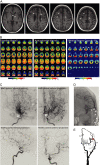The Genetic Basis of Moyamoya Disease
- PMID: 34529262
- PMCID: PMC8766392
- DOI: 10.1007/s12975-021-00940-2
The Genetic Basis of Moyamoya Disease
Abstract
Moyamoya disease (MMD) is a rare cerebrovascular disease characterized by progressive spontaneous bilateral occlusion of the intracranial internal cerebral arteries (ICA) and their major branches with compensatory capillary collaterals resembling a "puff of smoke" (Japanese: Moyamoya) on cerebral angiography. These pathological alterations of the vessels are called Moyamoya arteriopathy or vasculopathy and a further distinction is made between primary and secondary MMD. Clinical presentation depends on age and population, with hemorrhage and ischemic infarcts in particular leading to severe neurological dysfunction or even death. Although the diagnostic suspicion can be posed by MRA or CTA, cerebral angiography is mandatory for diagnostic confirmation. Since no therapy to limit the stenotic lesions or the development of a collateral network is available, the only treatment established so far is surgical revascularization. The pathophysiology still remains unknown. Due to the early age of onset, familial cases and the variable incidence rate between different ethnic groups, the focus was put on genetic aspects early on. Several genetic risk loci as well as individual risk genes have been reported; however, few of them could be replicated in independent series. Linkage studies revealed linkage to the 17q25 locus. Multiple studies on the association of SNPs and MMD have been conducted, mainly focussing on the endothelium, smooth muscle cells, cytokines and growth factors. A variant of the RNF213 gene was shown to be strongly associated with MMD with a founder effect in the East Asian population. Although it is unknown how mutations in the RNF213 gene, encoding for a ubiquitously expressed 591 kDa cytosolic protein, lead to clinical features of MMD, RNF213 has been confirmed as a susceptibility gene in several studies with a gene dosage-dependent clinical phenotype, allowing preventive screening and possibly the development of new therapeutic approaches. This review focuses on the genetic basis of primary MMD only.
Keywords: 17q25; Genetics; Moyamoya disease; RNF 213; Stroke.
© 2021. The Author(s).
Conflict of interest statement
The authors declare no competing interests.
Figures


References
-
- Takeuchi K, Shimizu K. Hypoplasia of the bilateral internal carotid arteries. Brain Nerve (Tokyo) 1957;9:37–43.
-
- Budişteanu M, et al. Neurofibromatosis type 1 associated with moyamoya syndrome. Case report and review of the literature. Rom J Morphol Embryol. 2019;60(2):713–716. - PubMed
Publication types
MeSH terms
Substances
Supplementary concepts
LinkOut - more resources
Full Text Sources
Miscellaneous
